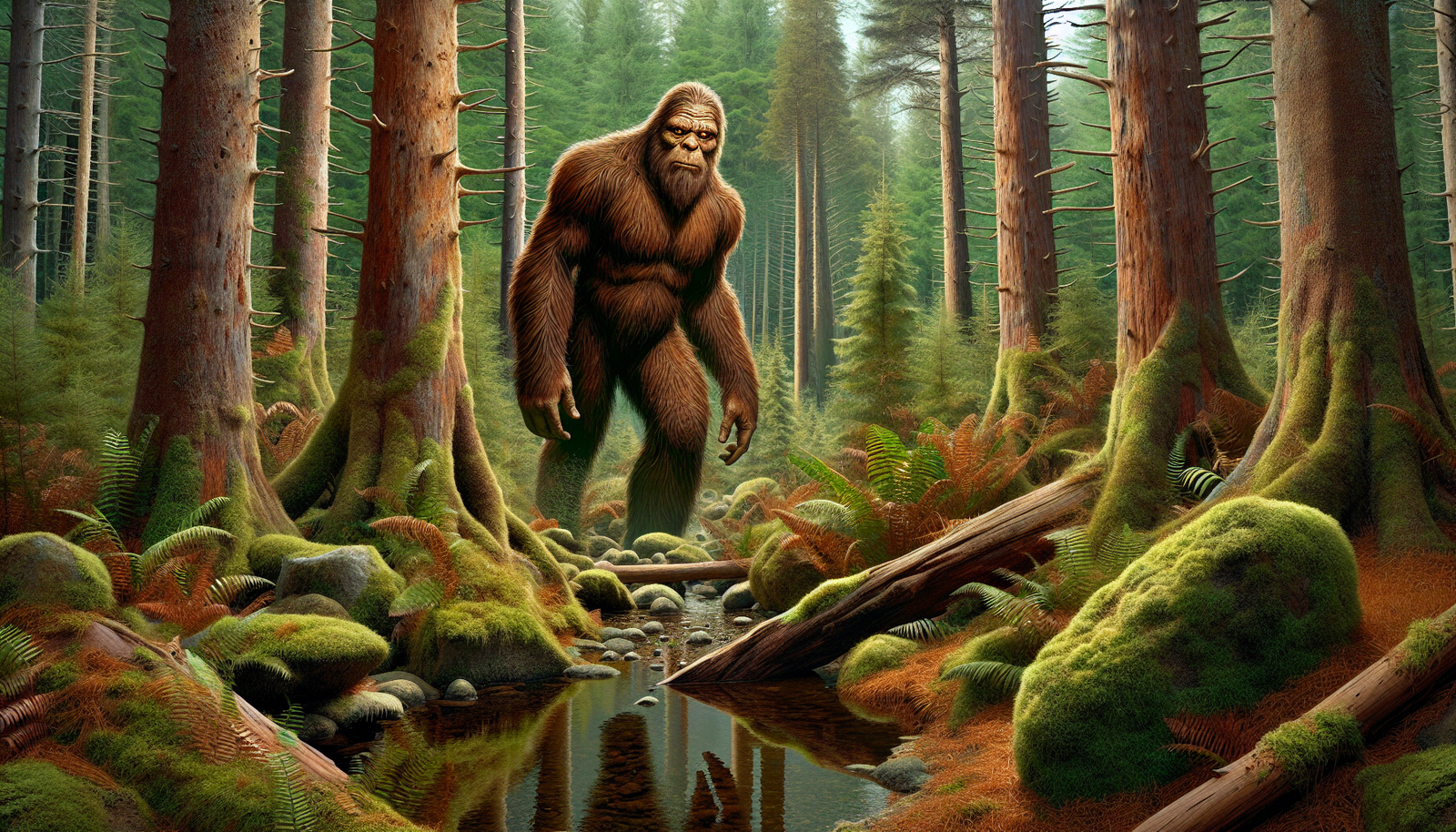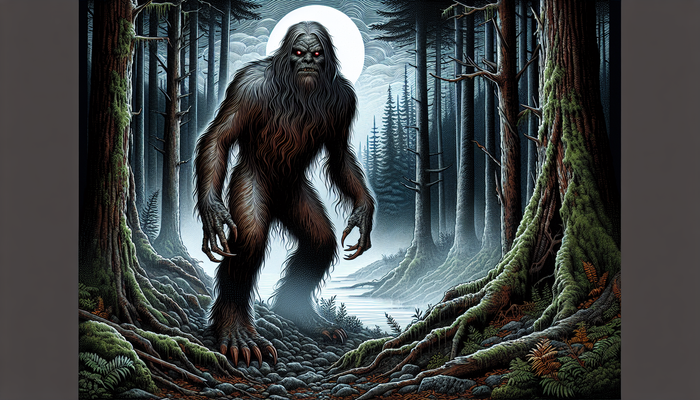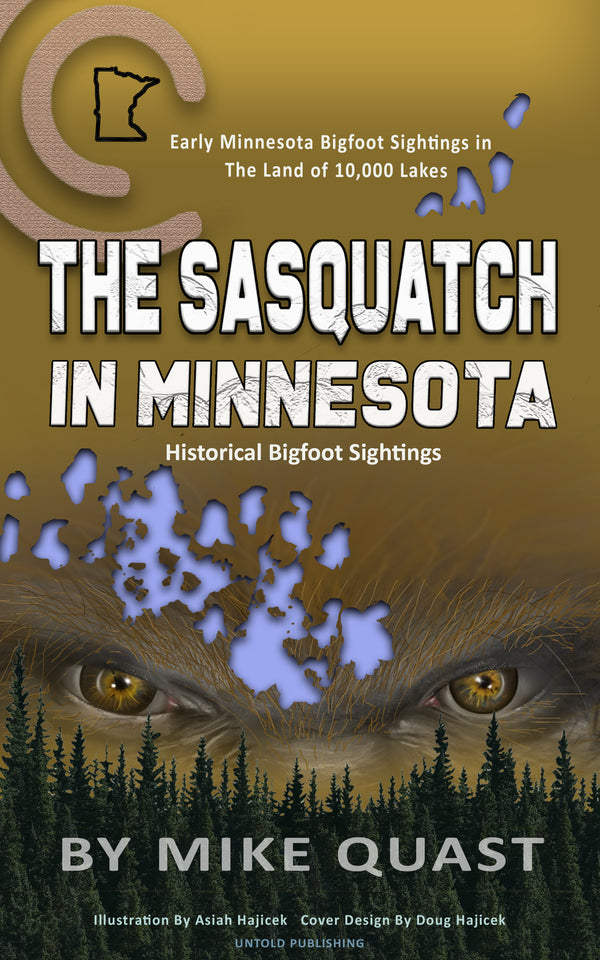New Hampshire Bigfoot Sightings

By Jack Sullivan, Cryptozoologist
There's something undeniably captivating about the unknown, especially when it comes to mysterious creatures that have captured our collective imagination for generations. Among these enigmatic beings, Bigfoot stands tall, both literally and figuratively. As a cryptozoologist and dedicated researcher, I've always been drawn to the rugged wilderness of New Hampshire, known as the Granite State. With its dense forests, towering mountains, and remote landscapes, it's the perfect habitat for a creature as elusive as Bigfoot.
New Hampshire boasts a rich history of Bigfoot sightings and encounters, dating back centuries to the indigenous legends of the region. These tales have persisted through time, evolving and adapting to the modern era, but never losing their power to intrigue and inspire. In this article, I aim to delve deep into New Hampshire's Bigfoot lore, examining the evidence, exploring the iconic encounters, and shedding light on the enduring mystery that has captivated so many.
The Origins of Bigfoot in New Hampshire
Long before the term "Bigfoot" entered the popular lexicon, the indigenous peoples of New Hampshire had their own legends of "wild men of the woods." These creatures were known by various names, such as Wood Devils and Shy Man, and were deeply ingrained in the folklore of the region. The Abenaki people, who have inhabited the area for centuries, have a particularly rich tradition of beliefs surrounding these mysterious forest-dwellers.
One of the earliest documented accounts of a Bigfoot-like creature in New Hampshire comes from an 1895 article in the Boston Globe. The piece described sightings of a "gorilla" in the woods near New Ipswich, with witnesses reporting a "great beast" that "jumped from the brush and disappear[ed] into the woods." Another incident mentioned a young man who heard "growling" and saw something in the brush near the Pleasant Street Cemetery, fleeing in terror. While the language used in the article is undoubtedly sensationalized, the core details of these reports are intriguing and suggest a long-standing history of encounters in the state.
It wasn't until the 1950s that the modern concept of Bigfoot began to take shape, with the term itself originating in northern California. However, the stories and legends of New Hampshire's "wild men" had already laid the groundwork for the Bigfoot phenomenon to take root in the Granite State.
New Hampshire's Bigfoot Hotspots
As I've immersed myself in the study of New Hampshire's Bigfoot sightings, certain regions have emerged as veritable hotspots for activity. One such area is the Ossipee Mountain Range, located in the south-central part of the state. This rugged, heavily forested landscape has been the site of numerous encounters and strange occurrences over the years.
Perhaps the most well-known incident from the Ossipee region is the Marlboro Monkey case of the 1970s. A couple hiking in the Marlborough quarries reported seeing a large, reddish-orange creature that seemed to be playing "hide and seek" with them, popping in and out of view among the rocks. The witnesses described the creature as resembling an orangutan and were so shaken by the experience that they quickly left the area.
Fast forward to 2003, and the Bigfoot Field Researchers Organization (BFRO) received a report of a loud, howling vocalization emanating from the woods near Marlborough. This report added another layer to the mystery surrounding the Ossipee Mountains. More recently, in 2021, a cluster of sightings emerged from the same general vicinity, including a delivery driver who claimed to have seen a Sasquatch crossing the road late at night.
Another hotspot that has captured my attention is the Pawtuckaway State Park region, situated in the southeastern part of the state. This area, characterized by its rugged terrain, dense forests, and numerous lakes and ponds, has long been associated with Bigfoot activity. In 2019, a local resident, whom I'll refer to as "Joe" to protect his privacy, reported a series of unsettling incidents. These included loud, clear "knocks" coming from the woods and a haunting, siren-like vocalization that he likened to a "World War II air raid siren."
Intriguingly, the BFRO has multiple reports on file from the Pawtuckaway area, further corroborating the notion that this region is a hub of Bigfoot activity. One particularly compelling case involves a set of tracks discovered in the snow, which were subsequently cast and analyzed, revealing some tantalizing details.
Iconic New Hampshire Bigfoot Encounters
Among the many Bigfoot encounters reported in New Hampshire, a few stand out as particularly iconic and well-documented. One such case is the Hollis "Flea Monster" incident of 1977. In the town of Hollis, located near the Massachusetts border, multiple witnesses reported sightings of a large, blondish-colored, hairy creature estimated to be around 8 feet tall.
The most dramatic encounter occurred at a local flea market, where a man and his sons were camping out overnight, waiting to sell their wares the next day. The family reported that their trailer began shaking violently, and when the father went to investigate, he either came face-to-face with the creature or shone his flashlight on it, only to have it stick its tongue out at him. Terrified, the family quickly fled the area, with the father later reporting the incident to the local police.
What sets this case apart is the involvement of Dr. Carleton Coon, a renowned Harvard anthropologist who took an interest in the incident. Coon traveled to the site, interviewed the witnesses, and even administered a polygraph test. He ultimately concluded that the man and his sons were credible and had indeed encountered something extraordinary.
Another iconic encounter that has captured my imagination is the "Juggernaut Snowball Sasquatch" incident of 1988 in the town of Bartlett. Two siblings, a 10-year-old boy and his 14-year-old sister, were playing in a large snow pile at the end of their driveway when they spotted a massive, heavily built creature. The boy likened the creature's appearance to the Marvel Comics character Juggernaut, describing it as around 6 feet tall with a broad, muscular build and no visible neck.
As the siblings watched in awe, the creature turned to face them, swaying side to side before effortlessly hopping up a 5-foot snow bank and disappearing into the woods. In a moment of bravery (or perhaps foolishness), the boy threw a hard-packed snowball at the creature, which sailed over its shoulder without eliciting a response.
What I find particularly compelling about this case are the vivid, specific details provided by the witness, as well as the comparison to a familiar comic book character. These elements add a layer of credibility to the account, as they suggest a level of careful observation and an attempt to relate the encounter to something tangible and recognizable.
The Enigmatic "Wood Devils" of the North Woods
In the northernmost reaches of New Hampshire, a different kind of Bigfoot legend persists – that of the enigmatic "Wood Devils" or "Shy Men." These tales speak of tall, gray, hairy creatures that lurk in the forests, hiding behind trees and rocks, and occasionally startling unsuspecting travelers and loggers.
The origins of these stories can be traced back to the late 19th century when the region was dominated by logging operations and adventurous outdoorsmen. The accounts of these "Wood Devils" have been passed down through generations, with some modern-day residents claiming to have heard the tales from their grandparents or great-grandparents.
What I find particularly intriguing about the "Wood Devil" legends is their potential connection to the indigenous Abenaki traditions and beliefs. It's possible that these stories represent a manifestation of ancient legends that have been adapted and evolved over time, reflecting the deep-rooted relationship between the Abenaki people and the forests they have called home for centuries.
Cryptozoological Investigations in the Granite State
As a cryptozoologist and filmmaker, I've had the privilege of conducting my own investigations into New Hampshire's Bigfoot phenomenon. One of my most memorable expeditions took me to the Pawtuckaway State Park area, where I collaborated with local researchers and witnesses to explore the region's history of Bigfoot activity.
During our investigation, we employed a variety of tools and techniques, including:
- Thermal cameras
- Night vision equipment
- Audio recorders
We meticulously scanned the landscape, hoping to capture evidence of Bigfoot's presence. While we didn't have any definitive sightings during our time in Pawtuckaway, we did experience some intriguing occurrences.
On one occasion, we heard a series of loud, unexplained noises coming from the direction of a nearby pond. These sounds seemed to defy easy explanation and left us scratching our heads. Additionally, we discovered several curious structures and markings in the woods that, while not conclusive evidence of Bigfoot, certainly piqued our interest and warranted further investigation.
One of the highlights of our Pawtuckaway expedition was the opportunity to interview a local resident who had his own Bigfoot encounter in the area several years prior. As he recounted his experience, I was struck by the vivid details of his account. He described a massive, bipedal creature standing just a few feet away from him, and the eerie vocalization that accompanied the sighting. His story, coupled with the sincerity and emotion in his voice, added another layer of intrigue to the mystery surrounding Bigfoot in New Hampshire.
In addition to our fieldwork, we also analyzed various pieces of physical evidence, including:
- Footprint casts
- Audio recordings of vocalizations and knocks
- Photographic and video documentation of potential Bigfoot activity
While much of this evidence remains inconclusive, it serves as a tantalizing glimpse into the possibilities that exist within the Granite State's forests.
Throughout my investigations, I've had the pleasure of collaborating with other dedicated researchers and organizations, such as the BFRO. By pooling our knowledge, resources, and expertise, we've been able to gain a more comprehensive understanding of the Bigfoot phenomenon in New Hampshire and beyond.
Theories and Explanations for New Hampshire's Bigfoot Phenomenon
As I've delved deeper into the mystery of Bigfoot in New Hampshire, I've encountered a range of theories and explanations that attempt to shed light on the phenomenon. One compelling idea is that the Granite State's unique environmental factors may play a role in attracting Bigfoot to the region.
New Hampshire's rugged terrain, dense forests, and remote wilderness areas provide an ideal habitat for a creature as elusive as Bigfoot. The abundance of water sources, such as lakes, ponds, and rivers, coupled with a diverse array of potential food sources, could sustain a population of these creatures. Additionally, the state's relatively low human population density may allow for more frequent encounters between Bigfoot and unsuspecting witnesses.
Some researchers have also suggested a possible connection between Bigfoot sightings and indigenous spiritual beliefs. The idea that the energy of the land itself may play a role in the presence of these creatures is an intriguing one, and it speaks to the deep, mystical relationship that the Abenaki people have with their environment.
Of course, there are also more scientific theories that attempt to explain the Bigfoot phenomenon. Some cryptozoologists propose that Bigfoot could be an undiscovered primate species, perhaps a relict population of a once more widespread creature. Others suggest that Bigfoot may be a form of ancient human, such as a surviving population of Neanderthals or another early hominid species.
Skeptics, on the other hand, offer alternative explanations for Bigfoot sightings. They argue that many encounters can be attributed to misidentifications of known animals, such as bears or moose, particularly under low-light conditions or when the witness is startled. Some skeptics also point to the possibility of hoaxes and fabricated evidence, citing the lack of definitive proof as a reason to doubt the existence of Bigfoot.
It's important to acknowledge the role that psychological and sociocultural factors may play in shaping perceptions and beliefs about Bigfoot. The power of suggestion, the influence of popular culture, and the human tendency to seek patterns and meaning in the unknown can all contribute to the enduring fascination with this cryptid.
The Enduring Legacy of Bigfoot in New Hampshire
Despite the ongoing debate surrounding the existence of Bigfoot, there's no denying the creature's enduring legacy in New Hampshire. The state's rich history of encounters, stretching from ancient indigenous legends to modern-day sightings, has left an indelible mark on the region's culture and identity.
Bigfoot has become a symbol of the mysteries and wonders that still exist within the natural world. The creature's elusiveness and the unanswered questions surrounding its existence serve as a reminder that there is still so much we have yet to discover and understand about the environment we inhabit.
For many researchers, myself included, the pursuit of Bigfoot is not just about proving the creature's existence; it's about the journey of discovery, the thrill of exploration, and the opportunity to contribute to our collective knowledge of the world around us. Each investigation, each piece of evidence, and each eyewitness account adds another layer to the complex tapestry of the Bigfoot phenomenon.
The enduring legacy of Bigfoot in New Hampshire also has important implications for conservation and ecology. The very idea that an undiscovered species could exist in our midst highlights the need to protect and preserve the state's wild spaces. By safeguarding the habitats that Bigfoot and other cryptids are believed to inhabit, we not only protect the possibility of their existence but also ensure the health and vitality of the ecosystems that support countless known species.
Moreover, the cultural impact of Bigfoot on local communities cannot be overstated. The creature has become a part of the state's folklore, woven into the fabric of its identity. Bigfoot-themed festivals, artwork, and even local businesses serve as a testament to the enduring fascination with this enigmatic being.
From Bigfoot to UFOs: Hangar 1 Publishing Has You Covered!
Explore Untold Stories: Venture into the world of UFOs, cryptids, Bigfoot, and beyond. Every story is a journey into the extraordinary.
Immersive Book Technology: Experience real videos, sights, and sounds within our books. Its not just reading; its an adventure.



























